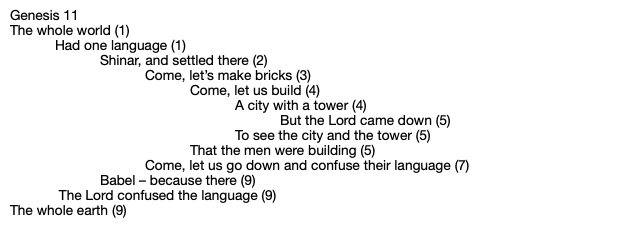CHIASTIC STRUCTURE
25/01/24 16:42
What we call CHIASM today was a common way of speaking and writing in Biblical times. There are several literary structures used in the Bible and the chiasm is one of the most complex and also revealing structures. Lost for centuries, chiasms have recently been re-realized and there's been many in-depth studies of chiasm by all literary scholars.
Chiasms give us a clue to what the author is emphasizing. I hate to be putting in such a complex study so early in this series but, with recent studies at our church gatherings, chiasm's have been in my face.
As mentioned earlier, chiasm's were widely used during the time of Biblical penning. While they were a way for someone to say something, or write something, that would allow the listener to be able to memorize it better due to a rhythmic pattern, they also allowed discovery into images and pictures. In Hebrew, there are no punctuation marks, therefore, chiasm's were used as a type of exclamation point. In the Bible, there are passages that are chiasm's, chapters, full books, and even the entire Bible. You will see that Christ even spoke in chiasm's.
The structure of a chiasm is like one side of an X, more like a > . The speaking or writing would have a type of parallel structure

Using the example above, the typical chiasm will have repeated phrases or sentiments across A - a, B - b, C - c, and so on. When seeing these repeated phrases, they are clues that a chiasm exists. Some chiastic structures may be seen through numbers used in the text or even size of sentences, although these can hardly be established without reading Hebrew. My most recent revealing of a chiastic structure was when looking at the Beatitudes in Matthew 5 where verse 3 and verse 10 have a complete quote: "For theres is the kingdom of Heaven". When going back through the Beatitudes, I noticed that, from outside to center, the result was a present tense verb (A - a), then a future passive (B - b), then a future active (C - c), then the center two were future passive (D - d). In this chiastic structure, the author was pointing out that the whole of the Beatitudes point towards righteousness and mercy together.
Some chiasm's have a two point center, as the example above, but some may have a one point center (being only one "D" in the example above). An example of a one point center can be seen in the article Eclipse where the center tells us what Messiah was pinpointing to the exact event in His statements about the Fig Tree, coming in the clouds, and the sun, moon, and stars darkening. Whether two points or one, the key to the subject being spoken about is the center. This does not mean the other points are not important but rather it lays a focus on the center point. Everything works to that center.
As mentioned earlier, another use of chiasm's as well as parallelisms is to add an exclamation point. If you locate a chiastic structure, which is not hard as Scripture is filled with them, you may notice the point goes to something we already knew. In our twenty-first century understanding, we bring presuppositions to the text and this can be good as long as we understand that the original reader may not have had these understandings. The author is using a chiasm for discovery to the original reader but also adding an exclamation point to the subject we may have already knew. As in the following chiasm where it points to "God is known" and "His Name is great" we understand this fact. But, now apply an exclamation point to this. I pray this does not gloss over your understanding as an exclamation point to the point of that chiasm is a great and wonderful thing in which we should lift our hands and praise YHWH.
I had a friend tell me that he was pretty secure in some of his beliefs of what he was seeing in Scripture until he learned about chiasm's and started seeing them all over the text. Pinpointing the center of the chiasm's awakened a whole new understanding, a Hebrew understanding, of what certain portions of text was trying to say, or trying to emphasize. Much of the text that used to seem counteracting now joins perfectly and makes sense. If you put away your preconceived notions, when finding chiasm's, and come to the text with an open mind, in understanding the Bible was written to a different people in a way we are not used to, chiasm's will open a whole new understanding of the Bible.
Let's look at a few chiasm's in Scripture and take notice the paralleling structure and what the speaker/author is pointing to in the subject.

The obvious focus of this little chiasm in Psalm is God

The obvious point in Matthew 6 is our contrasting relationship of trying to love both God and money. It's impossible.
Let's look at a chiasm in a chapter

The point of this chapter is the fall and judgment of man because of sin which will play out through the rest of history. But, the focus is on the promise to the serpent - "He will crush your head and bruise His heal"

Let's look at a book

I hope this will help in your study. Once realized, some people catch on and see these structures quickly and some may struggle. Some may never catch them but don't be discouraged. We know in part and prophesy in part. No one knows everything and likewise, no-one will see everything.
God Bless and enjoy delving into the wonderful picture album of God we know as the Bible.
Other articles that use the Chiastic Structure to find treasure in Scripture.
Eclipse
Beatitudes
Naming Them


